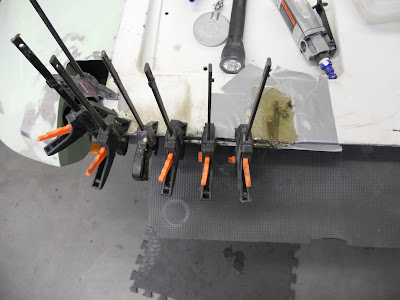Over the last few weeks I've been working on both sides of the hood. This includes grinding, fiberglassing and sand blasting. All the work was structural, nothing cosmetic.
You can see some repairs made to the top of the hood...
But most of the repairs were made to the underside. There were many cracks and holes all of which needed attention. This is a representative repair that was stuffed, plugged, ground then later laminated with fresh fiberglass. There were several of these.
This was a soft edge that needed to be built up then ground down to restore the edge.
When the repairs were complete it was off to the sandblaster to remove more of the old paint. 200 pounds of sand were used in total.
It turned out nice. In this picture there are at least a dozen repairs. It's looking good.
Here's the fuzzy hood I mentioned in the last post. It's paint remover hard at work. It removed about 70% of the old paint, the remainder required sandblasting and hours and hours of hand sanding.
It took a long time to get to this stage. The good news is the hood is structurally sound and I have no issues using this hood on our 63 Corvette.
The bad news is we haven't even started the finish work... Bondo, green primer, block sanding, etc.
Thanks for watching.






















